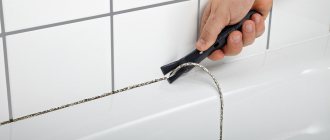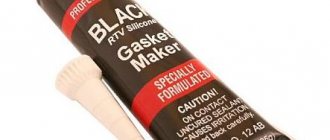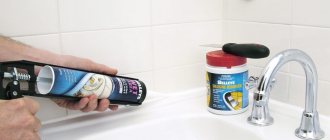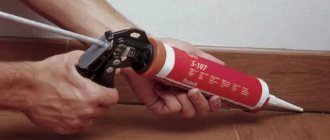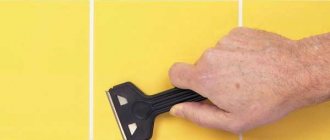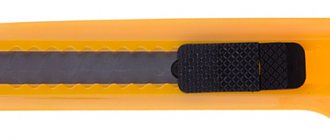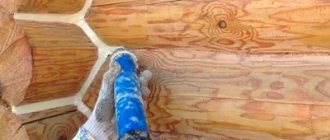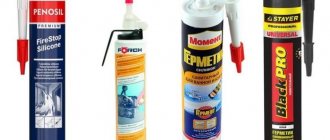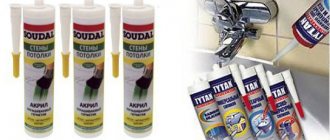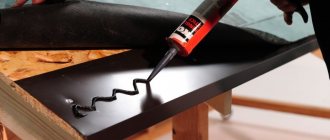Sealant is a paste-like product produced for the purpose of finishing work in the bathroom. It is with its help that the seams between the tiles are sealed, and the joints between the wall and the plumbing are insulated. The voids are filled with this product not only for aesthetic purposes, but also for the need to protect the surface from microorganisms and water.
Today, there are a huge number of hermetic compositions, and today in our review we will analyze the best options for such a product.
Acrylic
A sealant based on an aqueous dispersion of polymethyl acrylate is considered the simplest plastic. In addition to the main substance, the mixture contains thickeners, plasticizers and fillers. When applied to the surface, moisture quickly evaporates, which leads to polymerization.
Characteristics of the product
Acrylic bathroom sealant is used to fill cracks, through holes in bricks and cement. The material is suitable for connecting small and fixed elements:
- joints in pipes;
- cracks, jambs between walls;
- edges of bathroom furniture.
For work at high humidity, special types are used. The label may be marked “bathroom” or “sanitary.” The mixture contains antiseptic additives that do not allow bacteria and fungi to multiply. The building material is resistant to directed ultraviolet radiation and does not fade under the sun. The mass can withstand temperatures ranging from -25 C to +80 C.
Characteristics of the bath product Source eurobion.info
The polymerization process takes place in 2 stages. In the first 3 hours, a thin acrylic film appears on the surface. A person can remove the excess or add the missing substance. After a day, the product sets completely. Any interference with the coating structure reduces the protective properties of the mixture.
Acrylic sealants come in colored and transparent. The substance goes on sale packaged in tubes for construction guns, plastic buckets or soft tubes of various sizes. In undamaged packaging, the products will last a year. After opening, polymerization begins, so you need to have time to use it within 2-3 hours.
Features of insulating material Source industryremonta43.rf
Acrylic sealants are applied to the cleaned surface. Remove debris, dust and building mass residues from seams and gaps. The treatment area must be degreased and thoroughly dried. A special sealing cord will help reduce product consumption.
How to apply
To ensure that the sealing seam is even, apply masking tape to the walls and sides of the bathroom.
To seal seams, cracks and joints in the bathroom, use products in the form of a convenient applicator or additionally purchase a mechanical construction gun.
For application you will need:
- personal protective equipment (goggles or mask, gloves)
- clean cloth or rags
- acetone (technical alcohol may be used)
- masking tape
- leveling spatula
Plumbing sealant application
The process goes like this:
- The surface is wiped dry and degreased with acetone.
- Painting tape is glued along the entire length of the future seam so that the substance lies evenly and does not stain the surface
- Wear protective equipment and provide fresh air access to the room (when using toxic substances)
- The sealant tube is cut at an acute angle, and an applicator is put on for uniform application.
- The product is squeezed into a crack or gap, capturing both contacting surfaces
- The pressure on the tube must be constant, and the application line must remain continuous.
- The finished seam is leveled with a spatula
- The composition should harden (stop sticking to your hands) and then dry completely
Replacing the old seam follows the same procedure, with the only difference being that the previous composition must be carefully removed from the surface (mechanically or using a chemical solvent).
Perennial flowers (TOP 50 species): garden catalog for the garden with photos and names | Video + Reviews
Video description
Acrylic sealant for sealing joints, corners and cracks.
Advantages and disadvantages
Low price and fast polymerization are the main advantages of acrylic types. The dried surface can be painted with enamel and varnished. The building material contains no toxic substances, and the product does not stink during operation. The sealant has excellent adhesion to all popular surfaces. The mass does not crack during prolonged vibration with a small amplitude.
The sealant creates a very rigid seam, which bursts with slight expansion. The substance is not suitable for insulating an acrylic or steel bathtub (tray). Under loads, the structures move away, and the structure of the mixture gradually collapses.
Sealant for use in the bathroom Source nikastroy.ru
Acrylic types cannot be applied to a damp surface. The aqueous dispersion of the composition on a wet wall or furniture dissolves. In a bathroom, white sealant quickly turns yellow, so professionals advise using neutral transparent or colored ones.
Popular brands
CERESIT CS 15 (“Sanitary”) is the best sealant for acrylic bathrooms. The substance can be used without prior priming in rooms with high humidity. The product is suitable for filling cracks in cladding and for masking seams between plumbing fixtures and walls. Due to antiseptic additives, unfavorable conditions are created on the surface for the development of microorganisms.
Sanitary sealant "Ceresit" is not afraid of temperature changes. The composition can withstand single freezing (up to 14 days) without loss of characteristics. Immediately after drying, the seam or joint can be painted. The only drawback is that it spreads when applied in a thick layer.
Acrylic look for the bathroom Source festima.ru
Acrylic white VGP is an inexpensive and practical option that is worth using in the bathroom. The model is used for sealing narrow seams (up to 2 mm). The product is not destroyed under the influence of high humidity and is not afraid of temperature changes. The product provides a very strong and reliable coating when working with:
- ceramics;
- metal;
- glass;
- polyvinyl chloride.
If you need to close large cracks in the bathroom, then it is better to use sanitary acrylic “Moment Germent”. The sealant adheres to any materials. The treated surface dries quickly and does not leak. The product is produced in transparent and white form. Among the disadvantages, users note the thickening of the composition towards the end of the shelf life.
Sealant for wet rooms Source ozone.ru
Replacing old seams
After 5-7 years, even the most expensive sealants from famous brands can develop fungal compounds and mold, which not only spoil the entire aesthetics, but can also potentially cause harm to health.
Even periodic treatment of seams in the bathroom does not always produce the desired result.
Also, do not forget about microcracks that are a consequence of purchasing low-quality compounds or technical violations when applying the composition. Such connections need to be replaced.
How to proceed in this case? It’s definitely worth looking into this!
- The first step is to remove the old seam. As a rule, it will not cause any difficulty to carefully cut it off with a utility knife. You must act carefully; the new layer will not fit tightly on the old one.
- The second step on the path to success is ventilation.
- At the same time, mold and fungi are removed with an antiseptic. It is better to purchase sprayers for this, so the process will go more vigorously.
- You can begin laying a new seam, following the above technology.
However, it is not at all necessary to use sealant to seal the joints between the tiles and the bathtub (sink). Some people prefer not to seal the seams, but to install the corners with epoxy glue.
This solution to the issue is also acceptable. You will need to buy several longitudinal and corner strips, after which, after thoroughly cleaning the space, stick them on the tiles. The gap between the bathtub and the plank is not filled with glue; a sealant is used for this.
Portrait of a handsome construction worker
Silicone
The sealant is based on silicon. The properties of the durable substance were enhanced with the help of polymers and plasticizers. The viscous silicone rubber compound hardens at room temperature.
Characteristics of the substance
The products are divided into 2 groups based on their components. Acidic (acetate) types smell strongly of vinegar before they harden; you can recognize them by the letter “A” on the label. The models oxidize when applied to metal, so they are not suitable for working with cast iron and steel bathtubs. Neutral substances are more versatile in use, but are more expensive than the first varieties.
If you don’t know which silicone sealant is best for the bathroom, we recommend choosing sanitary types. The label should indicate that the product is water-resistant or can be used in wet conditions. One-component formulations are ready for use, so there is no need to mix ingredients.
Product for use in the bathroom Source sovety-vannoy.ru
Silicone sealants have high adhesive properties. The product adheres equally well to plastic and stone, metal and glass. The substance is used to seal joints on surfaces made of different materials. The composition is adjacent to drywall and drainpipes.
The silicone-based sealant dries in 2 stages. The first stage, when you can still adjust the weight, takes place within 30 minutes. Hardness gains gradually. Depending on the level of humidity and thickness of the layer, the period varies from 6 hours to 2 days.
Substance for insulating joints Source postroy-sam.com
The best sealant for an acrylic bathtub will contain silicone. After drying, the substance forms a dense and elastic seam. The strip does not crack when moving or under heavy load, so it is suitable for processing joints between walls and plumbing fixtures. After polymerization, the product shrinks by only 2%.
Fungicides are added to sanitary sealants during production. Antibacterial components kill microorganisms that develop in humid conditions. When working with such species, mold and mildew will not appear.
Sealing a Bathtub: 3 Easy Steps
To create an even and high-quality seam that will prevent water leaks and high humidity, use the instructions for working with the sealant:
- Make sure the sealing area is clean and free of dust and old sealant residue. If necessary, clean the surface, degrease it, and wipe it dry with a simple cloth.
- Select a sealant that suits the environmental conditions. If you are looking for a bathroom sealant, it should be a water-repellent formula. Some manufacturers offer sealants with additional protection against mold and mildew. Since a humid environment is favorable for the spread of germs, this option will help you get rid of unwanted unsanitary conditions. The easiest way to apply sealant is with a construction gun. Adjust the foam flow using the lever to create an even, single layer seam. Remove excess from the surface. If the gap between the bathtub and the wall is wide, use a roller for convenience.
- Smooth the solution to avoid unevenness. Prepare a solution at home from detergent and water in a 1:1 ratio. Dip your finger into the resulting liquid and smooth out the seam. As a result, you should have a perfectly even strip.
Video description
Silicone sealant: we go through corners and junctions.
Advantages and disadvantages
Resistance to mechanical damage is the main advantage of silicone sealant. After reaching maximum hardness, the seam is not afraid of exposure to abrasive cleaners and aggressive chemicals. The rubber in the mass allows the connected surfaces to remain elastic and movable.
If you don’t know which bathroom sealant is best, we recommend choosing silicone-based products. The sanitary appearance is not destroyed by direct sunlight. The substance does not lose its characteristics in conditions of high humidity and can withstand temperature fluctuations. The dyes in the composition do not stain the surfaces with which they come into contact.
Pros and cons of sealant Source domus.lg.ua
Rubber silicone sealant is more expensive than acrylic counterparts. The product is not universal, so it does not glue:
- polypropylene;
- PVC;
- polyethylene;
- fluoroplastic;
- polycarbonate
When working with the substance, it is necessary to clean the surfaces that are sealed. Before application, the area is degreased with alcohol and dried. The slightest debris or moisture impairs the adhesive properties of the mass.
TOP 5
RAVAK PROFESSIONAL X01200 is the best silicone sealant for the bathroom that does not darken. Antibacterial additives in the composition will rid the bathroom of mold. The product has high adhesion rates, so it glues any surface without the slightest leakage. The substance dries within an hour, and the color does not change during the entire service life.
The best sealant in the ranking Source san-like.ru
KRASS silicone bathtub sealant does not shrink after polymerization. A universal product that works with all materials. When applied to the surface, the mass completely fills all voids without draining. The substance has maximum UV protection, so the seam will retain its original color and will not darken over time.
KIM TEC SILICON ACETAT 101E sealant is suitable for repairing and gluing surfaces located in the bathroom. The product withstands changes in humidity and temperature, and the fungicidal additives in the composition do not allow microorganisms to multiply. The building material dries from 1 to 7 days. The only drawback is that the vinegar smell lasts up to 10 days.
BELINKA BELSIL SANITARY ACETATE is applied very evenly. Due to its thixotropic properties, it does not slip when working with vertical surfaces. The product is resistant to sun exposure, chemical solutions and sea water.
The best antibacterial sanitary sealant Source sformat.ru
MAKROFLEX Sx101 is the best silicone bathtub sealant with strong antibacterial properties. The building material is ideal for both the bathroom and the bathhouse. The product has high adhesion rates; when applied, a smooth line is obtained. The substance was packaged in small 85 ml tubes.
Polyurethane
Sealants are made from viscous polymer components of synthetic origin. Polyurethane types are designed for use under extreme conditions and under heavy loads. To improve characteristics, various additives are added to the composition.
Features of the product
Polyurethane varieties are considered one of the best sealants for the bathroom. The substances combine the functions of adhesive and insulating agents. Elastic properties reach 99%, which is higher than that of silicone options. Under any mechanical stress, corners and seams (old, new) will remain sealed. Sanitary models are often used to seal water pipe outlets and for gluing all types of surfaces.
Polyurethane sealants are resistant to vibration and corrosion. When used in damp conditions, the insulating qualities increase. The characteristics of the substance resemble polyurethane foam. After application to the surface, polymerization processes are activated, as a result of which the product dries quickly.
Elastic look for the bathroom Source decorstudia.com.ua
Video description
Polyurethane sealant. Application.
Advantages and disadvantages
Polyurethane sealant provides long-lasting, strong and flexible fixation. The composition has increased resistance to wear and mechanical damage. The product does not change color and characteristics when exposed to direct ultraviolet radiation and operation in humid conditions.
Polyurethane-based sealants do not lose their quality in frost and heat. The substance can be applied at -10 C and +40 C. When heated, the building material does not emit toxic fumes. Even in harsh weather conditions, the product will last 20-25 years.
A practical option for wet conditions Source kak-sdelano.ru
Polyurethane sealants do not smell and dry very quickly. On average, the first stage of polymerization takes 15-30 minutes. The setting speed is affected by the density of the layer and the level of humidity in the bathroom. After application, the product does not spread over a vertical surface. Using the material you can easily fix decorative details. A variety of shades will allow you to choose the color to match the design of the bathtub and tiles.
Polyurethane sealants have economical consumption. If you need to seal a seam 10 mm deep, then 100 ml of the substance is enough for 1 m. After hardening, the material does not deform or shrink. The product is recommended for use when connecting bathtubs and showers to the wall.
High price is the main disadvantage of polyurethane sealants. The cost of the cheapest types is more expensive than acrylic and silicone options. The product does not adhere well to plastics, so the seam is of poor quality. The substance must be applied to dry surfaces, although the defect can be neutralized by preliminary priming. Do not heat the mass to +120 C.
What is better to choose Source msk.s-stroy.ru
Popular types
The rating of the best bathtub sealants opens with Polyurethane 50 FC. The polyurethane version is used as a sealing material and adhesive for seams. The product dries in just 10 minutes, creating a very durable, elastic and resistant to mechanical stress surface. The universal material connects enameled, ceramic and metal (stainless steel, aluminum) elements. They are produced only in white and gray colors; they can be painted with dispersion enamels.
POLYFLEX-LM is a low-modulus one-component polyurethane-based sealant. The product glues almost all types of surfaces, including plastic (PVC, polyester). The film forms 15 minutes after application. The maximum seam width is 25 mm. The substance is not destroyed under the directed rays of the sun.
RUBBERFLEX PRO PU 25 will please you with increased elasticity, high-quality insulation and resistance to negative factors. After polymerization, the product can be painted with any enamel. The product belongs to the professional line, therefore it is packaged in bulk packaging (600 ml).
RABBERFLEX PRO PU 25 Source hyperdesmo.su
Selection rules
There are some useful tips for choosing the ideal sealant:
- if you have to seal the joints of a metal, acrylic bathtub, shower stall, then you should pay attention to MS polymers;
- The ideal solution for fixing mirrors would be polyurethane compounds or those containing silicone;
- The same polyurethane mixtures will help deal with fallen tiles; they quickly glue the element, do not shrink when drying, and therefore will not damage the tile;
- Silicone ones will help seal the leak and restore the threaded connection;
- To seal or install communications, you should pay attention to silicone-based compounds; they are the most suitable for such purposes.
- If polymers are used to seal joints, then it is worth selecting products that have antifungal properties.
It is best to give preference to sealants that have a viscous or paste-like consistency. Thanks to this structure, the product will be able to penetrate and fill even microcracks and crevices.
Each polymer is selected taking into account a specific task, only in this way can the maximum effect be achieved. In this case, the repair will last a long time, there will be no need to dismantle it, which means you will be able to avoid unnecessary expenses on materials.
MS polymer
Sealants combine the best characteristics of polyurethane and silicone types. An organosilicon group was added to the structure of the polyester compound. After contact with water, vulcanization occurs, as a result of which the mass acquires the properties of both substances.
Main settings
Hybrid sealant is a universal product that is used to seal and seal cracks. The substance is used when installing plumbing fixtures and sealing joints and pipes. The material will do an excellent job of gluing small parts (decor, hooks) and large elements in the bathroom.
Due to their high adhesive properties, hybrid sealants work well with all materials, even those with a non-porous structure. MS polymers can be used with:
- glass;
- mirrors;
- concrete;
- iron;
- plastic.
The drying time for hybrid sealants varies from 10 to 30 minutes. The speed is affected by humidity and temperature in the room. Polymerization occurs most quickly at +23 C, although you can work in any conditions. After hardening, a very dense, elastic seam is obtained that does not crack under load.
When working with the substance, minimal surface preparation is required, without primers. Hybrid sealants do not darken under the influence of aggressive environments and ultraviolet radiation. After hardening, the seams are not afraid of fresh and salt water, chemicals and abrasive detergents.
Hybrid solutions for the bathroom Source zen.yandex.com
Advantages and disadvantages
Ease of installation is the main advantage of MS polymers. Substances do not spread over horizontal, vertical and inclined surfaces. After application it is easy to get an even, smooth and neat seam. The product maintains elasticity within 25%.
Hybrid sealants are made from safe ingredients. The mass contains no toxic solvents, and the processed elements do not stink. Under the influence of high temperature and directed sunlight, no toxic substances are released from the material.
MS polymers harden quickly after application. To prevent mold from forming on the surface, fungicides were added to the composition. The seams can be painted after drying. When in contact with porous materials, the substances do not leave traces (do not stain).
MS polymeric substance Source kvmhcf.org
High cost is the main disadvantage of hybrid sealants. The product has just appeared on the market, so the price is an order of magnitude higher than other varieties. The invested amount will be repaid by durability (from 10 years) and ease of maintenance. Once cured, the substance is difficult to remove. Due to its resistance to chemicals, dried stains will have to be removed mechanically.
Types of sealants
Many compounds intended for insulating joints and seams belong to the class of sealants. Essentially, these are different compositions that are made from polymer materials with the addition of modifying substances. However, not all sealants can be used in bathrooms.
The following sealing compounds are intended for the bathroom:
- Polyurethane. This type creates a fairly dense coating and is characterized by adhesion to glass, brick, metal and concrete. The composition is resistant to ultraviolet rays, humidity and low temperatures. This sealant does not drain from vertically placed surfaces, provided that the layer width is at least 1 centimeter. Does not release toxic substances. The disadvantages include a not very high level of resistance to high temperatures.
- Silicone. This composition has excellent water-repellent properties. It is characterized by high adhesion to various materials, as well as a long service life and resistance to temperature changes. A cheaper acid sealant during the hardening process can provoke oxidation of the metal with which it acts. Therefore, it is better not to skimp on purchasing silicone bases.
- Acrylic. A practical sealant at a budget price. Has excellent adhesion, even to porous materials. There are no organic solvents in the composition, which means the coating will not have an unpleasant odor. The main disadvantage of this type is the low elasticity of the coating, so acrylic is mainly used only in those areas that are not subject to deformation.

